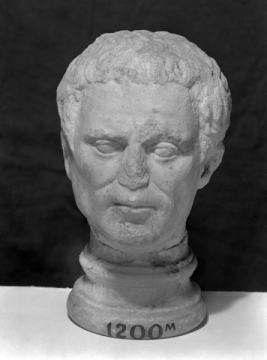Explore Collections


You are here:
CollectionsOnline
/
Head of a Roman man of the Flavian period
Browse
Curatorial note
A portrait of an unidentified man of early middle age; in spite of similarity to what is now defined as a Republican type, the face preserves its Flavian characteristics in the broad, squarely defined forehead contrasted with the realistically hard modelling of the lower portions of the face, about the cheeks, jaws, and mouth. Perhaps from a funerary monument of a personage of no particular importance.1
Work of the quality and condition of this small head finds many analogies in Republican portraiture and in those works for which a Republican or late Flavian dating is extremely difficult.2
A similar head, more Flavian than Roman Republican, was found in the Street of the Tombs at Assos in the Troad (modern day Behram in Turkey)3 and is in the Museum of Fine Arts, Boston. This head (accession no. 84.70), and others in Turkish museums, indicate that the Republican revival under Vespasian and Titus (69-81 AD) began, or flowered into its most sensitive creative level, in the Greek municipal and private (as opposed to purely imperial) workshops of western Asia Minor. Compare, in all these respects, the head of Vespasian (surely a municipal commission) in the Bergama (Pergamon) Museum, Turkey, from the acropolis of Pergamon.4
1 For better, but not dissimilar Flavian portrait busts, compare F. Poulsen, Greek and Roman Portraits in English Country Houses, trans. G.C. Richards, Oxford, 1923, p. 66, no. 47, formerly Lansdowne no. 54, now Copenhagen see F. Poulsen, Catalogue of ancient sculpture in the Ny Carlsberg Glyptotek, Copenhagen, 1951, no. 668a; and especially British Museum, see A.H. Smith, Catalogue of Sculpture in the department of Greek and Roman antiquities, British Museum, 3 vols, London, 1892-1904, no. 1975; E. Strong, Roman Sculpture from Augustus to Constantine, plate CXIII.
2 Compare Bernhard Schweitzer, Bildniskunst der Römischen Republik, Leipzig, 1948, nos. 24-43, etc.
3 The Troad or Troas Peninsula (in modern Turkish the Biga Peninsula) is on the Aegean coast of Turkey.
4 J. Inan and E. Rosenbaum, Roman and Early Byzantine Portrait Sculpture in Asia Minor, London, 1966, p. 67, no. 26, pl. XVI, 2-3.
Work of the quality and condition of this small head finds many analogies in Republican portraiture and in those works for which a Republican or late Flavian dating is extremely difficult.2
A similar head, more Flavian than Roman Republican, was found in the Street of the Tombs at Assos in the Troad (modern day Behram in Turkey)3 and is in the Museum of Fine Arts, Boston. This head (accession no. 84.70), and others in Turkish museums, indicate that the Republican revival under Vespasian and Titus (69-81 AD) began, or flowered into its most sensitive creative level, in the Greek municipal and private (as opposed to purely imperial) workshops of western Asia Minor. Compare, in all these respects, the head of Vespasian (surely a municipal commission) in the Bergama (Pergamon) Museum, Turkey, from the acropolis of Pergamon.4
1 For better, but not dissimilar Flavian portrait busts, compare F. Poulsen, Greek and Roman Portraits in English Country Houses, trans. G.C. Richards, Oxford, 1923, p. 66, no. 47, formerly Lansdowne no. 54, now Copenhagen see F. Poulsen, Catalogue of ancient sculpture in the Ny Carlsberg Glyptotek, Copenhagen, 1951, no. 668a; and especially British Museum, see A.H. Smith, Catalogue of Sculpture in the department of Greek and Roman antiquities, British Museum, 3 vols, London, 1892-1904, no. 1975; E. Strong, Roman Sculpture from Augustus to Constantine, plate CXIII.
2 Compare Bernhard Schweitzer, Bildniskunst der Römischen Republik, Leipzig, 1948, nos. 24-43, etc.
3 The Troad or Troas Peninsula (in modern Turkish the Biga Peninsula) is on the Aegean coast of Turkey.
4 J. Inan and E. Rosenbaum, Roman and Early Byzantine Portrait Sculpture in Asia Minor, London, 1966, p. 67, no. 26, pl. XVI, 2-3.
Unrecorded.
Soane collections online is being continually updated. If you wish to find out more or if you have any further information about this object please contact us: worksofart@soane.org.uk


